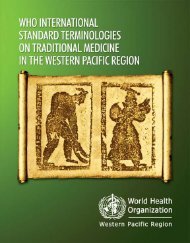Mercury Levels in Fijian Seafoods and Potential Health Implications
Mercury Levels in Fijian Seafoods and Potential Health Implications
Mercury Levels in Fijian Seafoods and Potential Health Implications
You also want an ePaper? Increase the reach of your titles
YUMPU automatically turns print PDFs into web optimized ePapers that Google loves.
6<br />
guidel<strong>in</strong>e levels. Bender <strong>and</strong> Williams (2000) reviewed US Food <strong>and</strong> Drug<br />
Adm<strong>in</strong>istration (USFDA) data <strong>and</strong> found that 36% of the swordfish, 33% of the shark<br />
<strong>and</strong> nearly 4% of large tuna sold commercially <strong>in</strong> US between 1992 <strong>and</strong> 1998 had a<br />
methylmercury content which exceeded 1 mg/kg. A separate US-based study showed that<br />
approximately three-quarters of the sharks <strong>and</strong> swordfish <strong>and</strong> one third of large tunas<br />
sampled exceeded 0.5 mg/kg Hg (Moore, 2000). Another previous long-term<br />
comprehensive survey <strong>in</strong> the United States exam<strong>in</strong>ed the occurrence of mercury (<strong>and</strong><br />
other trace elements) (<strong>in</strong>clud<strong>in</strong>g Hg) <strong>in</strong> 204 species of f<strong>in</strong>fish, molluscs <strong>and</strong> crustaceans<br />
from 198 coastal sites (USEPA, 1997). Several species had a mean Hg level of 0.4 to 0.5<br />
mg/kg or greater, such as barracuda, sharks, grouper, marl<strong>in</strong> <strong>and</strong> sailfish. These analyses<br />
were conducted <strong>in</strong> the 1970s but are still relevant as mercury levels <strong>in</strong> mar<strong>in</strong>e fish appear<br />
to have rema<strong>in</strong>ed relatively constant for over 20 years <strong>in</strong> various species (USEPA, 1997).<br />
Mar<strong>in</strong>e mammals, such as whales <strong>and</strong> dolph<strong>in</strong>s also have high levels of mercury (Endo et<br />
al. 2003) but the catch<strong>in</strong>g <strong>and</strong> consumption of these animals is not permitted <strong>in</strong> most<br />
Pacific Isl<strong>and</strong> countries. Contam<strong>in</strong>ation aris<strong>in</strong>g from urban areas may also result <strong>in</strong> higher<br />
mercury levels. Tissues from seven fish species from San Francisco Bay were analysed<br />
for Hg <strong>in</strong> 1994 <strong>and</strong> 1997 (Davis, 1997). More than half of the fish showed concentrations<br />
above 0.23 mg/kg. An overall average level of Hg for the seven species exam<strong>in</strong>ed was<br />
0.3 mg/kg with the highest level occurr<strong>in</strong>g <strong>in</strong> leopard sharks (>1 mg/kg) <strong>and</strong> <strong>in</strong> one<br />
striped bass sample (0.99 mg/kg).<br />
In the Pacific Isl<strong>and</strong>s, there have been only a few studies of mercury <strong>in</strong> shellfish<br />
(Morrison et al., 1997; 2001) from Fiji <strong>and</strong> some fish <strong>and</strong> canned tuna <strong>in</strong> Papua New<br />
Gu<strong>in</strong>ea (Kyle <strong>and</strong> Ghani, 1981; 1982a,b). This is of concern as fresh fish, shellfish,<br />
mussels <strong>and</strong> canned tuna <strong>and</strong> mackerel are major food sources for most Pacific Isl<strong>and</strong><br />
people. In addition there is currently no mercury data available for tuna which forms one<br />
of the largest <strong>in</strong>come earn<strong>in</strong>gs for Fiji <strong>and</strong> other Pacific Isl<strong>and</strong> countries.

















